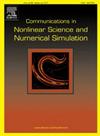Bifurcations of the superconductor–ferromagnet–superconductor φ0 Josephson junction
IF 3.4
2区 数学
Q1 MATHEMATICS, APPLIED
Communications in Nonlinear Science and Numerical Simulation
Pub Date : 2025-03-25
DOI:10.1016/j.cnsns.2025.108777
引用次数: 0
Abstract
A general method is presented to study the bifurcations that occur in models of anomalous Josephson junctions. To demonstrate the method, a bifurcation analysis is made of the superconductor–ferromagnet–superconductor Josephson junction, in which the Josephson to magnetic energy ratio and the direct current bias are used as the two control parameters. The recently developed embedding technique facilitates the use of standard numerical continuation techniques for the analysis. It reveals that the stability limit can be disrupted through either a Neimark–Sacker or period-doubling bifurcation. The corresponding one-parameter bifurcation manifolds delineate the regions in which further destabilisation occurs, finally leading to chaos. Furthermore, it is shown that the Floquet multipliers along the Neimark–Sacker bifurcation curve signal the synchronisation on the torus. Bi-stability also occurs in the system and is shown to originate from the generalised period-doubling and Chenciner bifurcations. The identification of regions in the parameter space where bi-stability occurs is important for applications which exploit such bi-stability to achieve controlled reorientation of the magnetisation and/or the switching from one voltage state to another.
求助全文
约1分钟内获得全文
求助全文
来源期刊

Communications in Nonlinear Science and Numerical Simulation
MATHEMATICS, APPLIED-MATHEMATICS, INTERDISCIPLINARY APPLICATIONS
CiteScore
6.80
自引率
7.70%
发文量
378
审稿时长
78 days
期刊介绍:
The journal publishes original research findings on experimental observation, mathematical modeling, theoretical analysis and numerical simulation, for more accurate description, better prediction or novel application, of nonlinear phenomena in science and engineering. It offers a venue for researchers to make rapid exchange of ideas and techniques in nonlinear science and complexity.
The submission of manuscripts with cross-disciplinary approaches in nonlinear science and complexity is particularly encouraged.
Topics of interest:
Nonlinear differential or delay equations, Lie group analysis and asymptotic methods, Discontinuous systems, Fractals, Fractional calculus and dynamics, Nonlinear effects in quantum mechanics, Nonlinear stochastic processes, Experimental nonlinear science, Time-series and signal analysis, Computational methods and simulations in nonlinear science and engineering, Control of dynamical systems, Synchronization, Lyapunov analysis, High-dimensional chaos and turbulence, Chaos in Hamiltonian systems, Integrable systems and solitons, Collective behavior in many-body systems, Biological physics and networks, Nonlinear mechanical systems, Complex systems and complexity.
No length limitation for contributions is set, but only concisely written manuscripts are published. Brief papers are published on the basis of Rapid Communications. Discussions of previously published papers are welcome.
 求助内容:
求助内容: 应助结果提醒方式:
应助结果提醒方式:


